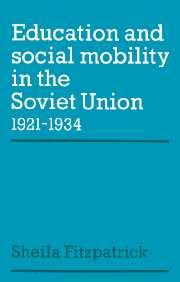11 - The ‘New Class’: social mobility and education under Stalin
Published online by Cambridge University Press: 11 November 2009
Summary
At the most practical level, the restoration of order which followed the Cultural Revolution meant a restructuring of the education system. In the new system that emerged in the 1930s, general secondary education led to higher education, and the VUZy recruited primarily from the secondary school. Vocational secondary education led to employment, and graduates of the FZU apprenticeship schools normally went directly into industry as workers.
In any other context but that of the Soviet Union in its first two decades, an education system of this type would be totally unremarkable. But, until the mid-1930s, Soviet higher schools had not recruited primarily from general secondary schools, and FZU apprentices had not normally become workers in industry. The peculiar characteristics of the Soviet education system before that time – entrance to higher education through rabfaks and preparatory courses; semi-vocationalization of general schools, accompanied by an involuntary conversion of vocational schools to serve general educational functions – were the products of revolutionary ideology, filtered through a mesh of conflicting institutional policies and priorities. They sprung from a general suspicion of inherited ‘bourgeois’ schools, and the desire to use education to create a new working-class elite.
When we find commonsense structural considerations superseding ideological ones, as they increasingly did after 1931, certain basic questions have to be asked.
- Type
- Chapter
- Information
- Education and Social Mobility in the Soviet Union 1921–1934 , pp. 234 - 254Publisher: Cambridge University PressPrint publication year: 1979



